Breeds
| Breed | Location of origin | Type | Body type | Coat type and length | Coat pattern | Image |
|---|---|---|---|---|---|---|
| Abyssinian [9] | Unspecified, but somewhere in Afro-Asia, likely Ethiopia [10] | Natural | Semi-foreign | Short | Ticked tabby |  |
| Aegean | Greece | Natural | Moderate | Semi-long | Multi-color |  |
| American Bobtail [11] | United States [12] | Mutation of shortened tail | Cobby | Semi-long | All |  |
| American Curl [13] | United States [12] | Mutation | Semi-foreign | Semi-long | All |  |
| American Shorthair | United States [12] | Natural | Cobby | Short | All |  |
| American Wirehair | United States [12] | Mutation | Normal | Rex | All |  |
| Aphrodite Giant | Cyprus | Natural | Lean and muscular | All | All |  |
| Arabian Mau | Arabian Peninsula | Natural | Moderate and muscular | Short | All |  |
| Asian | United Kingdom | Crossbreed between the Burmese and Chinchilla Persians | Moderate | Short | All without white and without siamese pointing |  |
| Asian Semi-longhair | United Kingdom | Crossbreed between the Burmese and Chinchilla Persians | Moderate | Semi-long | All without white and without siamese pointing |  |
| Australian Mist | Australia [14] | Crossbreed between the Abyssinian, Burmese, and Australian short-haired cats [14] | Moderate | Short | Spotted or marbled |  |
| Balinese | Developed in United States; [12] foundation stock from Thailand | Mutation of the Siamese | Semi-foreign | Long | Colorpoint |  |
| Bambino | United States [14] | Crossbreed between the Munchkin and Sphynx [14] | Dwarf | Short | Black + white hairless | |
| Bengal | Developed in United States, [14] but created in Asia | Hybrid of the Abyssinian and Egyptian Mau × leopard cat (Prionailurus bengalensis) | Large | Short | Spotted, marbled, or rosetted |  |
| Birman | Developed in France; foundation stock from Burma (Myanmar) [12] | The original Birman was crossed with the Siamese and the Persian to create the Birman of today. | Cobby | Semi-long | Mitted colorpoint |  |
| Bombay | United States and Burma (Myanmar) | Crossbreed between the Black American Shorthair and Sable Burmese | Cobby | Short | Solid black |  |
| Brazilian Shorthair | Brazil | Natural | Normal | Short | All |  |
| British Longhair | United Kingdom (England) [12] | Natural | Cobby | Semi-long | All | 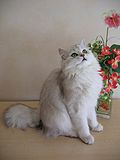 |
| British Shorthair | United Kingdom (England) [12] | Natural | Cobby | Short | All [15] |  |
| Burmese | Burma (Myanmar) [12] | Natural | Semi-foreign or semi-cobby | Short | Solid and Tortoiseshell [16] |  |
| Burmilla | United Kingdom (England) [12] | Crossbreed between the Burmese and the Chinchilla Persian | Semi-cobby | Short | Solid with Shaded Silver and Silver Tipped patterns |  |
| California Spangled | United States [12] | Crossbreed between the Abyssinian, American Shorthair and British Shorthair | Moderate | Short | Spotted tabby |  |
| Chantilly-Tiffany | United States | Natural | Cobby | Long | Solid, classic tabby, spotted tabby and ticked tabby |  |
| Chartreux | France [12] | Natural | Muscular; cobby | Short | Varying shades of blue |  |
| Chausie | United States | Hybrid of the Abyssinian × jungle cat (Felis chaus) | Normal | Short | Solid black, black grizzled tabby and black ticked tabby |  |
| Colorpoint Shorthair | United Kingdom (England) | Crossbreed between the Abyssinian, Siamese and short-haired cats | Foreign | Short | Colorpoint |  |
| Cornish Rex | Cornwall, England, United Kingdom | Mutation | Foreign | Rex | All |  |
| Cymric, Manx Longhair or Long-haired Manx [a] | Isle of Man, United States, and Canada [b] [12] | Mutation of the Manx (shortened tail) | Semi-cobby | Long | All |  |
| Cyprus | Cyprus | Natural | Lean and muscular | All | All |  |
| Devon Rex | Buckfastleigh, Devon, England, United Kingdom | Mutation | Semi-foreign | Rex | All |  |
| Donskoy or Don Sphynx | Russia | Mutation | Semi-foreign | Hairless | Solid |  |
| Dragon Li or Chinese Li Hua | China | Natural | Normal | Short | Ticked tabby | 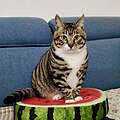 |
| Dwelf | United States | Crossbreed between the American Curl, Munchkin and Sphynx | Dwarf | Hairless | All | |
| Egyptian Mau | Egypt [12] | Natural | Moderate and muscular | Short | Spotted tabby | 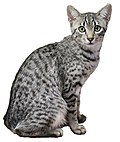 |
| European Shorthair | Continental Europe [12] | Natural | Moderate | Short | All |  |
| Exotic Shorthair | United States [12] | Crossbreed between the American Shorthair and Persian | Cobby | Short | All |  |
| Foldex [17] | Canada | Crossbreed between the Exotic Shorthair and Scottish Fold | Cobby | Short | All |  |
| German Rex | Germany [12] | Mutation | Semi-foreign | Rex | All |  |
| Havana Brown | United Kingdom (England); foundation stock from Thailand | Crossbreed between the Siamese and black short-haired cats | Semi-foreign | Short | Solid brown |  |
| Highlander | United States | Crossbreed between the Desert Lynx and Jungle Curl | Moderate | Short/long | All |  |
| Himalayan or Colorpoint Persian [c] | United States and United Kingdom [12] | Crossbreed between the Persian and Siamese | Cobby | Long | Colorpoint |  |
| Jianzhou cat | China | Natural | Normal | Short | Multi-color |  |
| Japanese Bobtail | Japan [d] [12] | Mutation of shortened tail | Moderate | Short/long | All |  |
| Javanese or Colorpoint Longhair [e] | Developed in United States [12] and Canada; foundation stock from Southeast Asia | Crossbreed between the Balinese (with some Colorpoint Shorthair), Oriental Longhair and Siamese | Oriental | Long | Colorpoint |  |
| Kanaani | Israel [14] | Hybrid of short-haired cats × African wildcat (Felis lybica) | Semi-foreign | Short | Solid black, chocolate spotted tabby or cinnamon spotted tabby |  |
| Karelian Bobtail | Ladoga Karelia, Russia [18] | Natural, mutation of shortened tail [19] | Medium [20] | Short/long [21] | All, except pointed | |
| Khao Manee | Thailand [14] | Natural | Moderate | Short | Solid white |  |
| Kinkalow | United States | Crossbreed between the Munchkin and American Curl | Dwarf | Short | All |  |
| Korat | Thailand [12] | Natural | Semi-foreign or semi-cobby and muscular | Short | Solid blue |  |
| Korean Bobtail | Korea | Natural, mutation of shortened tail | Moderate | Short/long | All |  |
| Korn Ja or Konja [ citation needed ] | Thailand | Natural | Small | Short | Solid black | |
| Kurilian Bobtail or Kuril Islands Bobtail | Kuril Islands, North Pacific [14] | Natural, mutation of shortened tail | Semi-cobby | Short/long [14] | All |  |
| Lambkin | United States [12] | Crossbreed between the Munchkin and Selkirk Rex | Dwarf | Rex | All | |
| LaPerm | United States [12] | Mutation | Moderate | Rex | All |  |
| Lykoi | United States | Mutation | Moderate | Sparse haired | Black roan |  |
| Maine Coon | United States [12] | Natural, crossbreed | Large | Semi-long/long | All excluding chocolate and colourpoint |  |
| Manx | Isle of Man [12] | Mutation of shortened tail | Moderate | Short/long | All |  |
| Mekong Bobtail | Developed in Russia; foundation stock ultimately from Southeast Asia [14] | Mutation of shortened tail | Moderate | Short | Colorpoint |  |
| Minskin | United States [14] | Crossbreed between the Munchkin, Burmese, Devon Rex, and Sphynx | Dwarf | Hairless | All |  |
| Minuet | United States | Crossbreed between the Persian and Munchkin | Dwarf | Short/long | All | 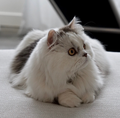 |
| Munchkin | United States [12] | Mutation of dwarf cat | Dwarf | Short/long | All | 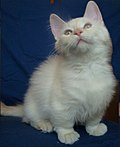 |
| Nebelung | United States [14] | Natural, mutation | Foreign | Semi-long | Solid blue |  |
| Neva Masquerade (colorpoint Siberian) [f] | Russia [14] | Crossbreed between the Siberian and a colorpoint cat [23] | Cobby [14] | Long [14] | Colorpoint |  |
| Norwegian Forest cat | Norway [12] | Natural | Cobby | Long | Chocolate or orange and white bicolor | 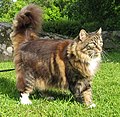 |
| Ocicat | United States [12] | Crossbreed between the Abyssinian, American Shorthair and Siamese | Large | Short | Spotted tabby |  |
| Ojos Azules (extinct) | United States [12] | Crossbreed | Moderate | Short | All |  |
| Oriental Bicolor | Developed in United States and United Kingdom, later in Continental Europe; foundation stock ultimately from Thailand | Color variety of the Oriental Shorthair | Oriental | Short | Bicolor |  |
| Oriental Longhair [g] | Developed in United States and United Kingdom; foundation stock ultimately from Thailand [12] | Crossbreed between the Oriental Shorthair and long-haired cats | Oriental | Semi-long | All; if colorpoint is considered to be a separate breed, it is called the Javanese |  |
| Oriental Shorthair [g] | Developed in United States and United Kingdom; foundation stock ultimately from Thailand [12] | Crossbreed between the European Shorthair and Siamese | Oriental | Short | All |  |
| Persian (modern) | Developed in United States and Europe; foundation stock from Greater Iran [12] | Mutation of the Traditional Persian | Cobby | Long | All but colorpoint |  |
| Persian (traditional) | Greater Iran [12] | Natural, but some crossbreeding with the Turkish Angora | Cobby | Long | All but colorpoint |  |
| Peterbald | Russia | Crossbreed between the Donskoy, Oriental Shorthair and Siamese; before this, it was between the Balinese and Javanese | Oriental | Hairless, velour, brush, or straight coat | All |  |
| Pixie-bob | United States [12] | Mutation (falsely claimed to be a hybrid of the domestic cat and the bobcat (Lynx rufus) early on) | Medium | Short | Spotted tabby |  |
| Ragamuffin or Liebling (obsolete) | United States | Crossbreed between the Ragdoll with limited out-crossing to the Himalayan, the Persian, and other long-haired cats | Cobby | Long | All | 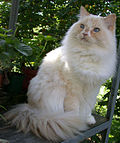 |
| Ragdoll | United States [12] | Behavioral mutation in a crossbreed, presumed to be between the Persian or Turkish Angora and the Birman or Burmese | Cobby | Long | Colorpoint, mitted, or bicolor | 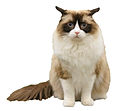 |
| Raas | Raas Island, Indonesia | Natural | Moderate | Short | Solid blue, solid cinnamon, or cinnamon colorpoint |  |
| Russian Blue | Russia [12] | Natural | Moderate, Oriental | Short | Solid blue |  |
| Russian White, Russian Black and Russian Tabby | Developed in Australia; foundation stock from Russia | Crossbreeds between the Russian Blue and short-haired cats from Siberia, Russia | Moderate | Short | Solid white, solid black and tabby |  |
| Sam Sawet | Thailand | Color variety of the Thai | Moderate | Short | Solid |  |
| Savannah | United States [14] | Hybrid of the domestic cat x serval (Leptailurus serval) [24] | Large | Short | Spotted |  |
| Scottish Fold | United Kingdom (Scotland) [12] | Mutation of the bones and cartilage of the ears | Cobby | Short/long | All |  |
| Selkirk Rex | United States in 1988 [12] | Mutation/crossbreed between the American Shorthair, Persian, Himalayan, Exotic Shorthair and British Shorthair | Large and cobby | Short/long (longhair, sometimes in early generations, can appear to be semi-long) | All |  |
| Serengeti | United States | Crossbreed/hybrid between the Bengal and Oriental Shorthair | Oriental | Short | Spotted |  |
| Siamese (modern) ) | Developed in United States and Europe; foundation stock from Thailand [12] | Mutation of the Thai | Oriental | Short | Colorpoint |  |
| Siberian or Siberian Forest Cat ) | Siberian Tundra, Russia. | Natural | Cobby [14] | Long [14] | All; except chocolate, lilac, cinnamon, and fawn [22] |  |
| Singapura | Developed in United States; foundation stock from Singapore [12] | Possibly a mutation of a crossbreed (excluding the Munchkin), solving why they are so small | Small | Short | Ticked tabby |  |
| Snowshoe | United States [12] | Crossbreed between the American Shorthair and Siamese | Moderate | Short | Mitted colorpoint |  |
| Sokoke | Kenya [14] | Natural | Moderate | Short | Ticked tabby |  |
| Somali | United States, Canada | Mutation | Cobby | Long | Ticked tabby |  |
| Sphynx | Canada, Europe [12] | Mutation | Oriental | Hairless | All |  |
| Suphalak | Thailand | Natural | Moderate | Short | Solid reddish-brown |  |
| Thai or Traditional, Classic, or Old-style Siamese; Wichien Maat [h] | Developed in Europe; [14] foundation stock from Thailand [12] | Natural | Moderate | Short | Colorpoint |  |
| Thai Lilac, Thai Blue Point and Thai Lilac Point | Thailand | Color varieties of the Korat | Moderate | Short | Solid lilac and colorpoint (blue point and lilac point only) |  |
| Tonkinese | Canada, United States [12] | Crossbreed between the Burmese and Siamese | Oriental | Short | Colorpoint, mink, or solid | 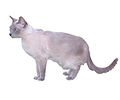 |
| Toybob | Russia | Mutation | Dwarf | Short | All | |
| Toyger | United States [14] | Crossbreed/hybrid between the Bengal and short-haired cats | Moderate | Short | Mackerel tabby |  |
| Turkish Angora | Turkey [12] | Natural | Semi-cobby | Semi-long | All |  |
| Turkish Van [i] | Developed in United Kingdom; foundation stock from Turkey [14] | Natural | Semi-cobby | Semi-long | Van pattern | 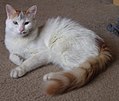 |
| Turkish Vankedisi (white variety of Turkish Van) [i] | Developed in United Kingdom; foundation stock from Turkey [14] | Natural | Svelte | Long | Solid white | 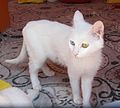 |
| Ukrainian Levkoy | Ukraine | Crossbreed between the Donskoy and Scottish Fold | Moderate | Hairless | Solid gray |  |
| York Chocolate | New York, United States | Natural | Moderate | Long | Solid chocolate, solid lilac and solid taupe or any of these colors with white |  |